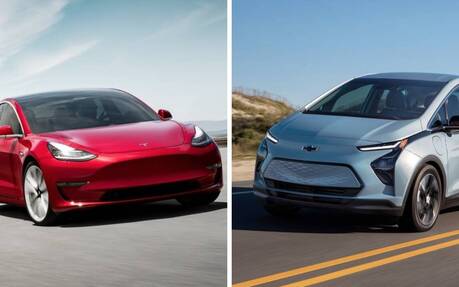2021 Tesla Model 3 vs. 2022 Chevrolet Bolt EV: The Numbers
For 2022, the Chevrolet Bolt EV gets a number of styling revisions and new technologies along with a sizable price cut. Meanwhile, the Tesla Model 3 keeps leading EV sales with unmatched range and breathtaking acceleration.
Despite their vast differences, these two cars are similar in many ways. Which one is better? To help settle the debate, we’ve compared the numbers and specs. Here’s what we found…
- Also: 2022 Chevrolet Bolt EV: Cheaper AND Better
- Also: The Car Guide's Best Buys for 2021: Tesla Model 3 and Model Y
Range: Model 3
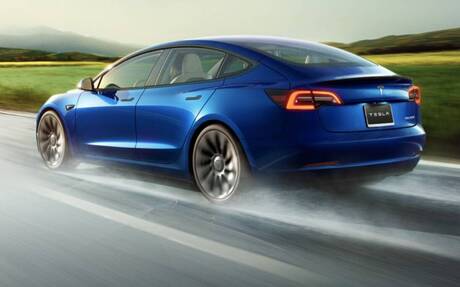
Range is a key factor for EV buyers. With a 66-kWh battery, the Chevrolet Bolt EV can travel up to 417 kilometres, which is impressive enough.
On the other hand, the Tesla Model 3 is slightly better in Standard Plus trim at 423 kilometres. If you select the dual-motor Long Range or Performance variant, you’re looking at 568 or 507 kilometres, respectively.
We forgot to mention that the Model 3 is also available in Standard trim with a software-locked range of 151 kilometres. Virtually nobody chooses this model, which merely exists to qualify for the federal government’s EV incentive of $5,000.
Charging: Model 3
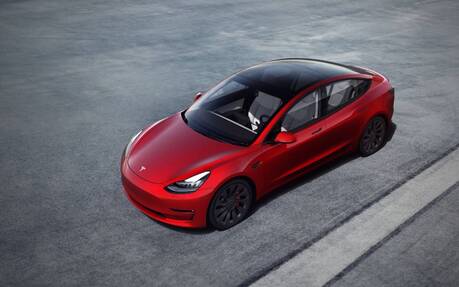
Using a 240V power source, the Chevrolet Bolt EV will fully charge in seven hours. Now, if you plug it into a DC fast charger, the automaker claims you can get 160 kilometres of range in 30 minutes.
At Tesla, the Model 3 Standard Plus can be fully charged in 8.5 hours. The Long Range and Performance variants require a bit more time—up to 10 hours. Still, Tesla has the edge thanks to its Supercharger stations, which allow the Model 3 to regain about 282 kilometres in half an hour.
Practicality: Bolt EV
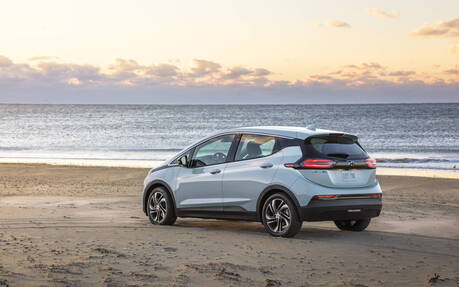
The Chevrolet Bolt EV offers more cargo space with 470 litres when the rear seats are up. Fold them down, and you get 1,614 litres for your luggage and other gear.
The Model 3’s trunk is a tad smaller with a capacity of 425 litres, but don’t forget the front storage compartment under the hood.
In both cars, the rear seatbacks are split 60/40.
Safety: Tie
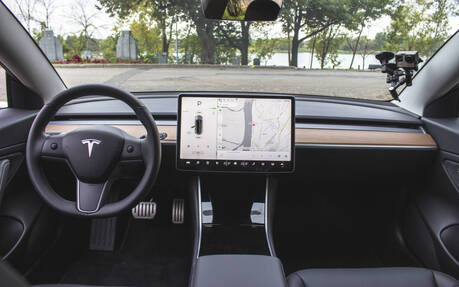
You’re properly protected no matter which vehicle you pick. The Chevrolet Bolt EV comes with advanced safety and driver assistance technologies such as forward collision alert, automatic emergency braking, front pedestrian braking, lane departure warning, lane keeping assist and following distance indicator.
What’s more, rear cross traffic alert, blind spot monitoring and a rear parking assist are standard equipment on both cars. The U.S. Insurance Institute for Highway Safety (IIHS) has not yet rated the 2022 Bolt EV.
Tesla offers Autopilot semi-autonomous driving technology with the Model 3. However, units manufactured after May 1 use Tesla Vision instead, which relies exclusively on cameras. The IIHS therefore took away the Model 3’s Top Safety Pick+ while it further assesses the new system.
Like the Bolt EV, the Model 3 features forward collision alert, automatic emergency braking, front pedestrian braking, lane departure warning and lane keeping assist.
In-car Technology: Tie
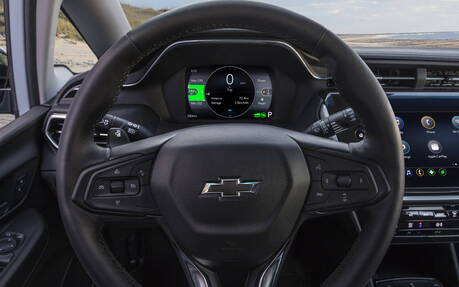
You’ll find essentially the same level of technology and convenience inside the two EVs. In the Tesla Model 3, a single 15-inch display is your central hub for all vehicle settings, functions and infotainment. You can sign up for access to popular apps like YouTube, Netflix or Twitch. What’s more, updates to the system and more can be done over the air.
The Chevy Bolt EV is a bit more conventional with two separate displays—an eight-inch instrument panel behind the steering wheel and a 10.2-inch touchscreen for infotainment. Apple CarPlay and Android Auto compatibility comes standard, as do other services like Amazon Alexa, Spotify and The Weather Channel. A 4G LTE hot spot is optional.
We can’t declare a winner, here. It all depends on your preferences.
Price: Bolt EV
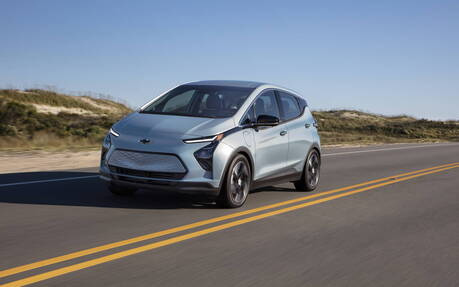
While Tesla is advertising a cheap entry-level variant of the Model 3, most of the lineup is significantly more expensive, especially the Long Range and Performance variants.
The 2022 Chevrolet Bolt EV carries a base MSRP of $38,198, a drop of $6,800 from the outgoing 2021 model ($44,998). The Tesla Model 3 starts at $44,999 for the Standard Range trim with just 151 kilometres of range. The more popular Standard Range Plus retails from $51,600. These prices do not include destination and handling charges.
The federal rebate of $5,000 applies to the Bolt EV and the two cheaper Model 3s. Provincial incentives can be as high as $8,000 in Quebec.
Warranty: Model 3
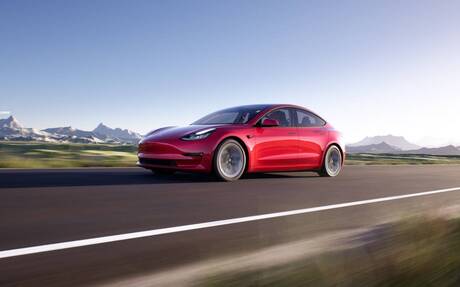
Tesla has hands down the best coverage including a limited vehicle warranty of four years or 80,000 kilometres, whichever occurs first, versus three years/60,000 km for Chevrolet. It’s the same thing with rust perforation. Tesla offers 12 years or unlimited mileage, while Chevrolet’s warranty is six years/160,000 km.
In both cases, electric powertrain components are backed for eight years. However, there’s a limit of 240,000 kilometres with Tesla and 160,000 kilometres with the bowtie brand.
